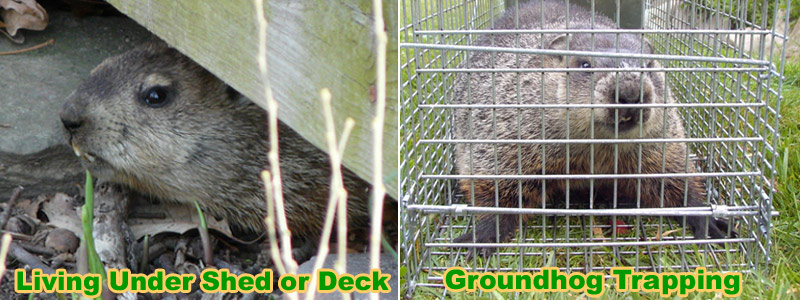The groundhog, also known as a woodchuck, is a smart rodent that sometimes sets up camp beneath a shed or under a deck. While it seems counterintuitive for a mostly herbivorous creature to want to live so close to humans and domestic animals, if you know a little bit about groundhogs, you’ll see just why they like to live where they do.

Most animals that are inclined to dig live in some sort of burrow. Groundhogs are no exception, and they will often live alone or with one or two others in a network of tunnels. If you look at your shed through the eyes of a groundhog, what you see is a perfect place to create a dry, stable burrow. The floor to a shed can make an impressive ceiling for a large woodchuck home. With that thought in mind, consider the architecture of your deck. Usually raised off the ground with support beams, a deck offers protection from the rain as well as an area to come above ground without being detected. Under the safety of a deck, the groundhog can examine the yard before it decides to embark on a quest for food. We can’t fault these animals for using our buildings to their advantage; in fact, it is quite ingenious how they can adapt to enhance their own lives through the use of our architecture. Admiration aside, a groundhog under your deck or shed can seriously compromise the structural integrity of that building. An animal this close to your home should be trapped and removed.
Prior to professional intervention, exclusion tactics are helpful ways to keep groundhogs from infiltrating your buildings. Heavy gauge wire mesh can be placed around the base of structures, always flush with the ground and with an outward flare. This flare puzzles most animals and prevents them from burrowing under the fence. Whatever barrier you select, you should make sure it is completely flush to the ground. The spaces beneath decks and sheds are what draw the groundhogs in the first place. With proper, preventative exclusion tactics, you forego the need to advance to the next step: removing the groundhog.
No matter how often it is said that trapping and removal is the best idea, some people are bound and determined to try the repellents and home remedies on the market. Because you’ve probably already sent your spouse out the buy mothballs, you should know that mothballs almost never work to deter a pest. The aroma of mothballs is easily covered up with one kick of loose dirt, and to make matters worse, the carcinogen inside the tiny, white balls is toxic to humans and pets. Not exactly what you want running into your water system after a rain shower. Predator scents are another waste of your money and effort. It may be true that a woodchuck will be wary if it smells the odor of a natural predator, but wary and scared senseless are two very different things. In nature, the scent of something acts as a warning, not necessarily as a deal breaker. If a predator is both seen and smelled, then it’s time to pick a new location to call home.
Just because it’s important for a predator to be both seen and identified by scent doesn’t mean it’s a wise idea to get a large dog to root out your groundhog. Groundhogs are very aggressive and can cause deep lacerations with their teeth. Aside from the risk of you dog losing an eye or ear, there is a very real chance the groundhog is infected with rabies. For this reason, it may be in your best interest to hire a professional to trap and remove the unwanted rodent.
Go back to the main
woodchuck removal page.